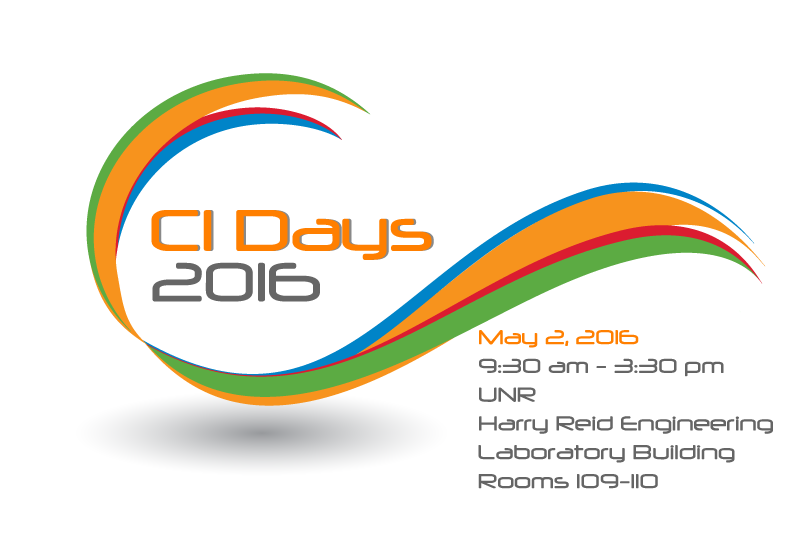
P O S T E R S E S S I O N
Applying Assistive Technologies to Improve User Experience with the Virtual Watershed Platform
Authors – Angela Chan and Sergiu Dascalu
University of Nevada, Reno
This poster introduces the research and development of assistive technologies, focusing more on the Brain-Computer Interface (BCI) software component, which is aimed towards people with motor disabilities. Assistive technologies (ATs) have become recent subjects of interest due to the yearly increasing prevalence rates in impairments. We developed the Sim-Assist system to allow users to interact with a three-dimensional simulation of the game Air Hockey in a hands-free manner. The results obtained from testing our system provided insight into how we will incorporate its concepts into other three-dimensional simulations. This poster provides an overview of our approach in applying ATs into the Virtual Watershed Platform.
Efficient Secure Data Dissemination in Decentralized Personal Networks
Authors – Esra Erdin, Eric Klukovich and Mehmet Hadi Gunes
University of Nevada, Reno
Tremendous increase in the usage of mobile devices and interconnected applications have brought privacy concerns for the end users of these systems. The privacy concerns of users’ personal data can be addressed with decentralized architectures. The distributed platforms remove central authorities from the networked systems as users share their content only with intended peers through mobile devices. In a decentralized architecture, efficient sharing and timely access of objects play a vital role. To address these challenges we take advantage of free storage clouds to distribute encrypted user content. In this study, we develop algorithms and protocols to achieve efficient and secure data dissemination through networked mobile devices utilizing storage cloud infrastructure.
Enabling data-driven research with cloud computing
Authors – Zhao Fu and Mei Yang
University of Nevada, Las Vegas
With the growing size of research data in solar energy, water and environment, researchers now need to take the computation and storage limitation into consideration while they explore the mathematical model of their problem in their research. This may seriously affect the accuracy of the research product if the dataset is not large enough. To meet the higher demand of storage, computation and security in research, our group has designed a scalable 11-node cloud computing center. In this cloud computing center, the state-of-the-art research tools, like OpenStack, Spark, Hadoop, Jupyter, Python, Octave and R, have been installed in the server. Two workshops have been held and more than 35 researchers have attended to test the stability and performance of the system. Also, some big data benchmarks have been tested on the platform. All the tests show the system works well even under a relatively high work load.
Artificial Neural Network
Authors – Moinul Hossain, Banafsheh Rekabdar, Sergiu Dascalu, and Sushil Louis
University of Nevada, Reno
We investigate a deep learning Artificial Neural Network approach for creating weather forecast models using the climate data from the Nevada Climate Change Portal. Neural Networks are useful for modelling highly nonlinear and chaotic processes like weather. With the recent interest in deep learning Neural Networks, we explored the feasibility of a deep learning approach called Stacked Denoising Auto-Encoders for building forecast models that predict hourly air temperature. We considered historical hourly temperature, barometric pressure, humidity and wind speed data for building the model. We collected and processed the raw data from the Nevada Climate Change Portal subscribed sensors and use this data to empirically compare the performance of stacked denoising auto-encoders against traditional neural nets at predicting temperature. Experimental test results show that, with a good choice of parameters, stacked denoising auto-encoders achieved up to 98% accuracy in predicting temperature, beating traditional neural networks. Our results provide further empirical evidence of the broad applicability of deep neural networks.
Comparison of Cloud and Social Network Data Transfer Performance on Mobile Platforms
Authors – Eric Klukovich, Mehmet H. Gunes and Gurhan Gunduz
University of Nevada, Reno
Within the last few years, the number of mobile devices has seen immense growth. Users are constantly relying on them to access data and to communicate with other people. Mobile devices have a limited amount of storage space available, so often times a user stores them on free storage clouds, and communication is commonly done through social networks. End users expect fast delivery of data, while the provider must locate the data and transfer it to a large number of users. In this study, we focus on analyzing cloud and social network provider data transfer performance to understand how these providers handle data dissemination and their Quality of Service (QoS). We examine two popular social networks: Facebook and Google+, along with several cloud storage providers: Copy Cloud, Dropbox, Google Drive, Mediafire, and OneDrive, on mobile devices. A measurement application was developed on the Android operating system that measures the download and upload times of each provider for smart phones and tablets. The measurements were performed at different locations over Wi-Fi and 3G/4G access to create a realistic scenario of mobile device usage. Overall, we found that cloud storage and online social networks (OSN) have comparable QoS, but OSNs are slightly more efficient for smaller file transfers.
Compression of Climate Data Using Multilayer Neural Networks
Authors – Ruxing Li, Astha Puri, Bharath Chandra Mummadisetty and Shahram Latifi
University of Nevada, Las Vegas
We describe a method for lossless compression of climate data based on predictive and differential coding. The prediction of climate data is performed by using multilayer neural networks (MLNN). The difference between actual and predicted data is calculated and encoded using Huffman coding. As training data sets, the humidity data for year 2013 and temperature data for years 1999 to 2011 were used. For testing, humidity data for year 2014 and temperature data for year 2012 were used. Root mean square error (RMSE) was used as the evaluation parameter to test the network performance. Compared to standard data compression algorithms, higher compression ratios (CRs) are achieved using the MLNN prediction method. High CRs increase bandwidth and storage capacity; therefore, this study could help relieve the congestion in climate data storage and transmission and improve the effectiveness of climate data analysis.
Building a scalable infrastructure to drive next generation research
Authors – Xiangrong Ma and Yingtao Jiang
University of Nevada, Las Vegas
Data is shining nowadays, but with large, more varied and complex structure with the difficulties of storing, analyzing and visualizing for further processes or results. In this poster we will reveal the rationale behind the UNLV CI node platform by diving into the internal design and architecture aspects.
NRDC Android QA App
Authors – Hannah Munoz, Samantha Grant, Matthew Salivar, Vinh Le, Royal Stewart, Eric Fritzinger, Sergiu Dascalu and Fred Harris
University of Nevada, Reno
NRDC Android QA App is an application for the Android mobile platform. It is intended to be used by technicians of the Solar Energy-Water-Environment Nexus project who are working on the thirteen remote research sites across Nevada that are gathering varied climate data. These research sites gather data non-stop every minute every day, and the data is streamed to and stored by the Nevada Research Data Center (NRDC). The application is design to enable the technicians to add information and service-related entries about these research sites during their trip to site locations. This in turn will provide a convenient transfer of data between technicians and the NRDC’s database. Our objective is to provide the field technicians with an positive and satisfying experience when servicing these stations, as well as an effective method of creating documentation for their work.

Hannah Munoz

Samantha Grant

Matthew Salivar

Royal Stewart

Vinh Le

Eric Fritzinger
A New Workflow for Interacting and Visualizing Big Data for Web Applications
Authors – Rui Wu, Sergiu Dascalu and Fred Harris
University of Nevada, Reno
Interaction and visualization are two significant methods for both business people and scientists to find “gold nuggets” buried in raw data. These two methods can help understand complex theories and make it easier for people from different research areas to cooperate. Many prevalent web-based data interaction and visualization tools and libraries are not as effective as before because of big data. Most of the traditional client/server web application visualization tools and libraries process visualization and interaction on the client side. This workflow requires the server side to transfer data to the client side. If the data size is very large, the data transferring time is unbearable. In this poster, we propose a fast and new method for client/server web application to interact with and visualize big data. The method visualizes data on the server side with multiple CPU cores and transfers resulting images to the client side. The client side collects users’ interaction information and the server side updates visualization results based on the interaction information. We tested the workflow with large volume datasets and the results have been promising in terms of faster speed than with traditional workflows.










